Planeology Explained
October 2013
- by Kelvin Miyahira
Now that we have seen a lot of steeper looking backswings than the faddish flat, one plane backswings, it’s time to investigate the downswing plane. So this month, let’s look at the different players and their swing planes to see if we can sort out the idea of the downswing plane in better way than we have in the past.
Difficulty in describing

How do we make sense of this? Who’s steeper? Who’s flatter?
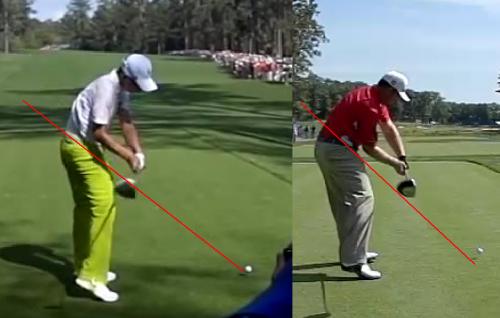
Now what?

And here?
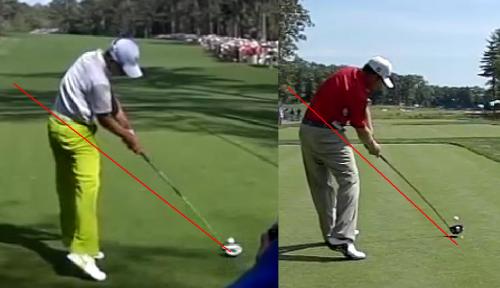
How is Guan steeper yet swinging farther to the right?
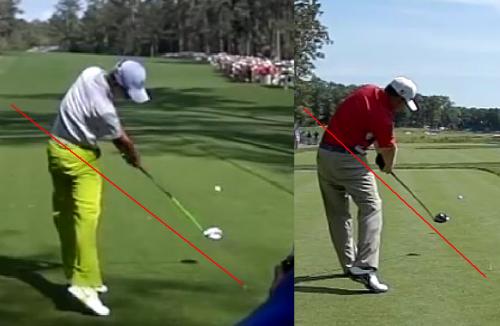
JB is more closely following his plane line with the path moving left.
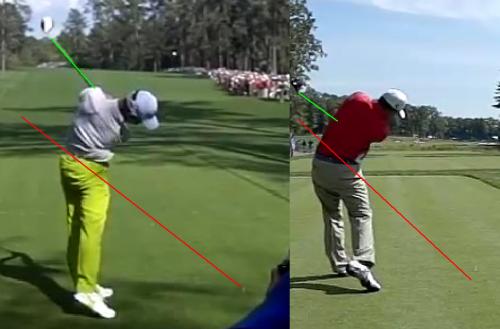
Why is Guan’s follow through higher?

Tigeresque follow-though and a perfectly balanced finish by Guan must mean that everything was just perfect through impact right? Surely his swing must be perfect since he’s in balance at the end.
Upon Further Review...
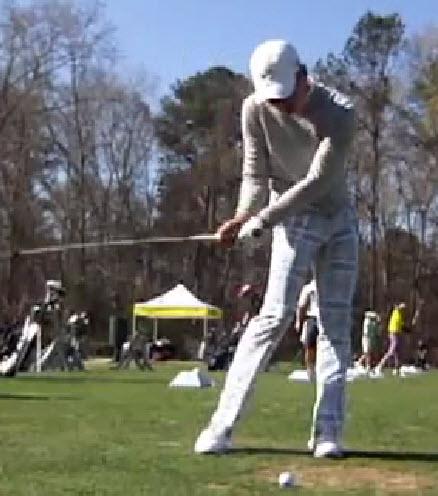
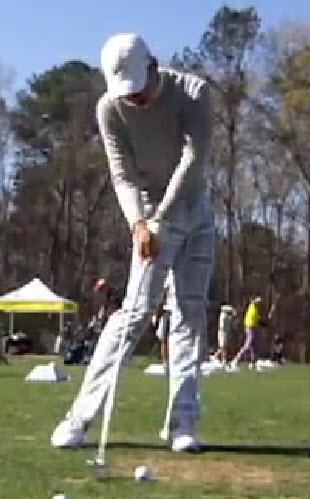
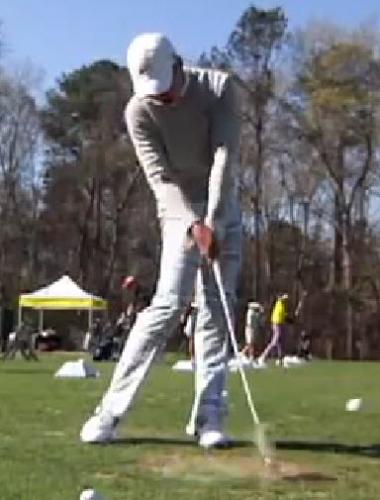
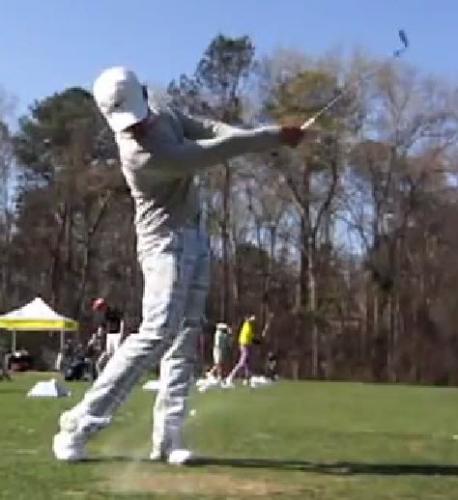

Oh my. Is Guan a mighty flipper? No wonder he lacks distance. But he has such a beautiful follow through. “He really fires that right side through impact,” as Sir Faldo would say... But I digress.
Complexifying the Plane
Let’s get on to the topic of complexifying the plane. So here’s my take on it. There are two different parts of the plane that we must be aware of. First, there is the clubhead/shaft plane and second the arm/hand plane. These two variables give us four possible combinations:
- Steep shaft with steep hands = steep (over the top)
- Flat shaft with flat hands = flat (usually stuck)
- Steep shaft with flat hands = steep and stuck
- Flat shaft with steep hands = flat and over
A fifth option could be added called “on plane” but we need to define that somehow. Couldn’t someone be “on plane” yet be stuck? - On plane = ???

With his hands at waist level, Guan looks a bit stuck with his right elbow but has a steep shaft angle. So that’s option #3 steep and stuck.
JB looks slightly flatter than parallel and well above the initial shaft plane yet his hands are outside his feet line and pointed left or target. Well his shaft could be considered flat but his hands are steep and over. So I guess that’s option #4 flat (shaft) and over (arms).
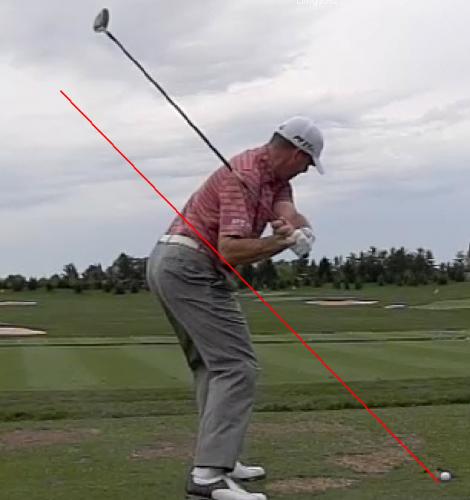
Here’s Robert Garrigus with option #4 - flat shaft and over with the hands/arms.

But it can change as does Guan’s. Now Garrigus is using option #1, steep clubhead/steep hands.
This undoubtedly is going to have an effect on the swing path and the release style. So what we are seeing is a path moving left due to his arms moving from out-to-in (shoulder flexion moving to extension from sagittal view) and this will move his club in similar path.
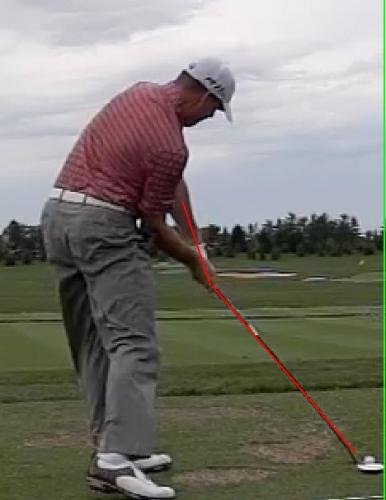
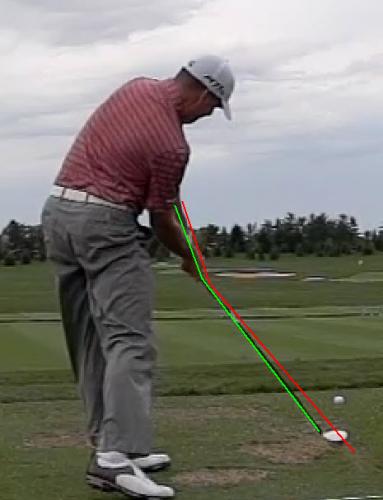
Moving to UD max through impact helps Garrigus’ club move left through impact.
This along with his great body rotation and drive/hold release pattern matches his preferred ball flight, a fade.
Guan’s Stuck and Steep

So we see how Guan’s steep and stuck position halfway on the downswing affects his arm swing. Since his arm starts from a position more behind him (right shoulder extension sagittal view) it will move out toward the ball (shoulder flexion) thus making his swing path move to the right.
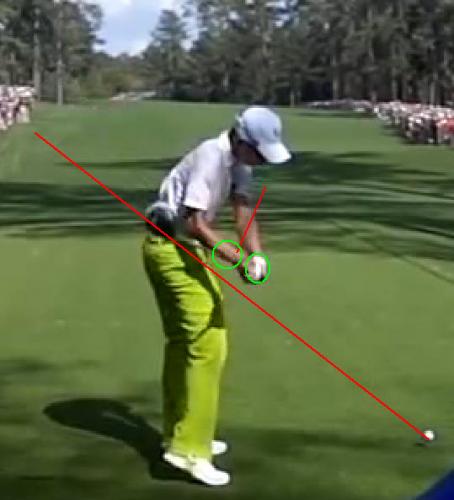
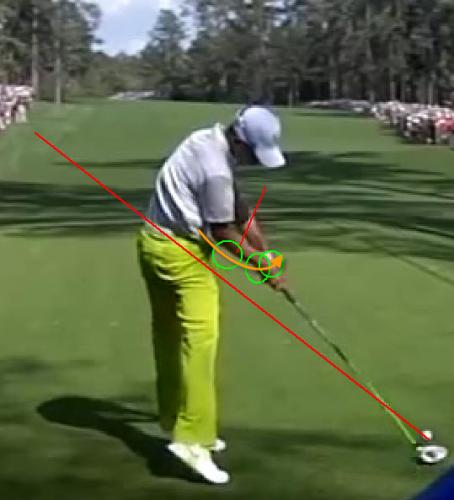
He recovers by externally rotating his right shoulder a bit late and this swings his club more under the plane.
Do not try this at home! Interestingly enough, Guan has a downswing for his irons that is different from his driver.
What is “On Plane?”
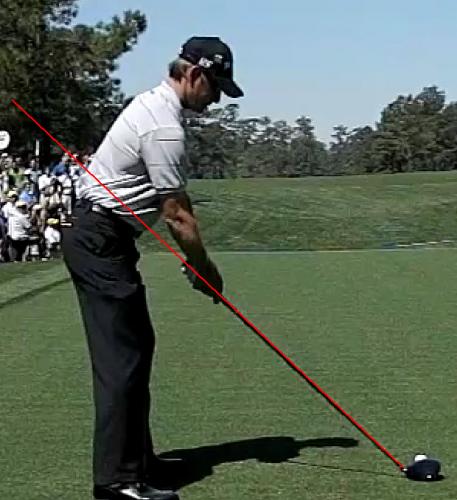
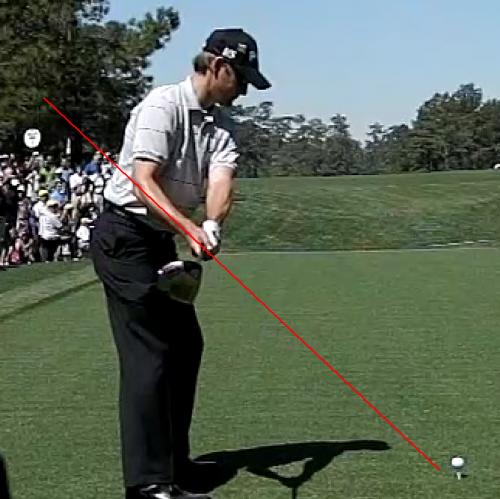
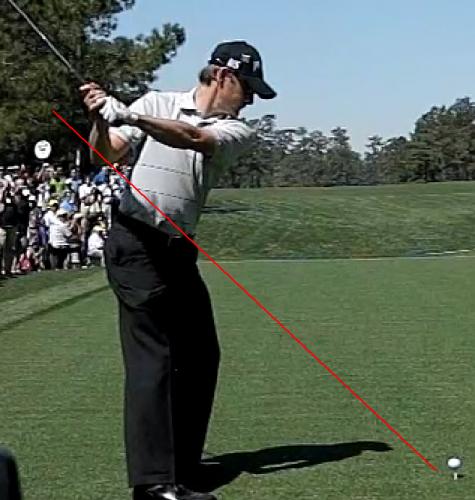
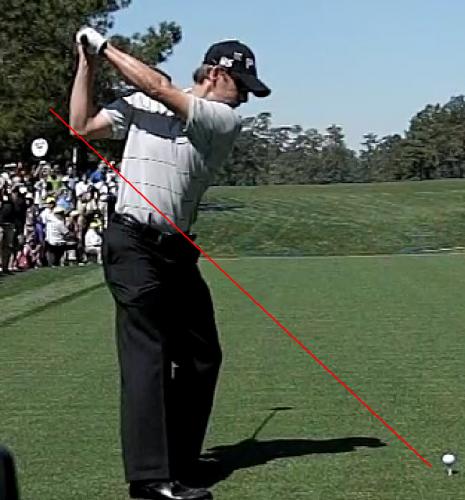
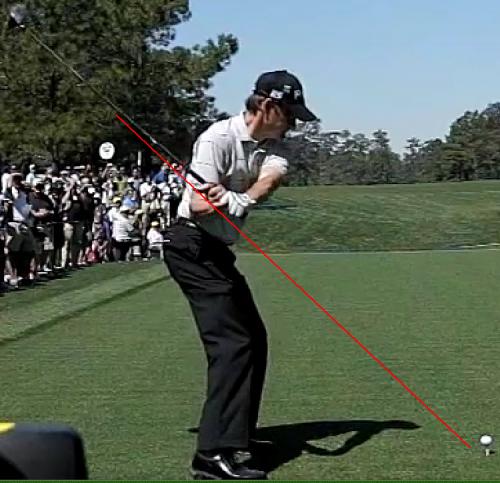
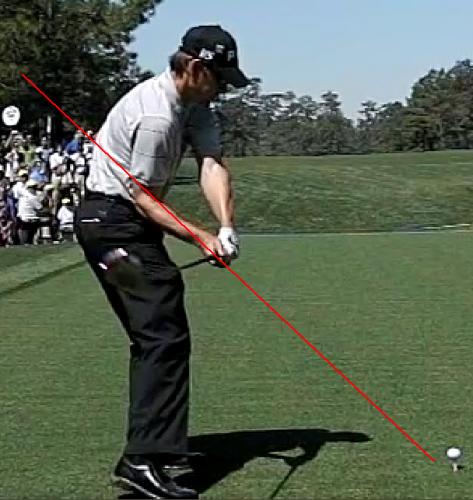
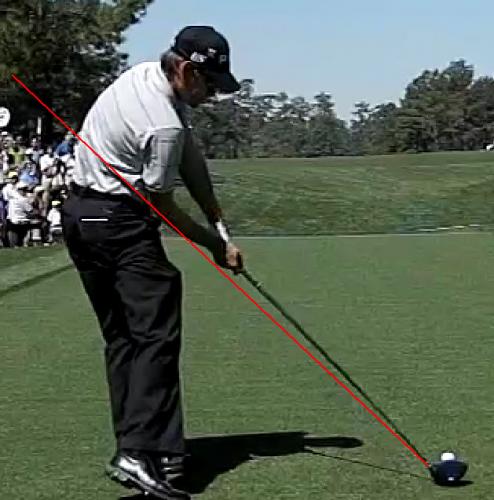
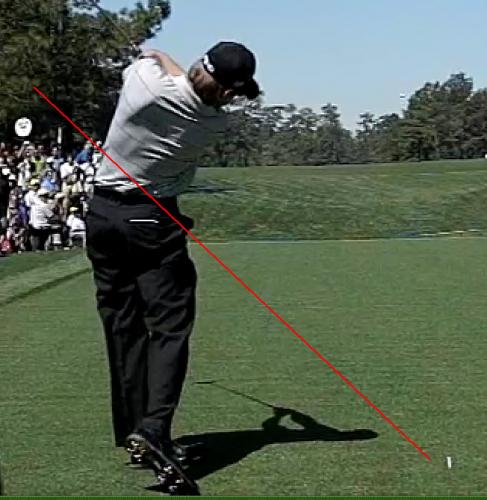
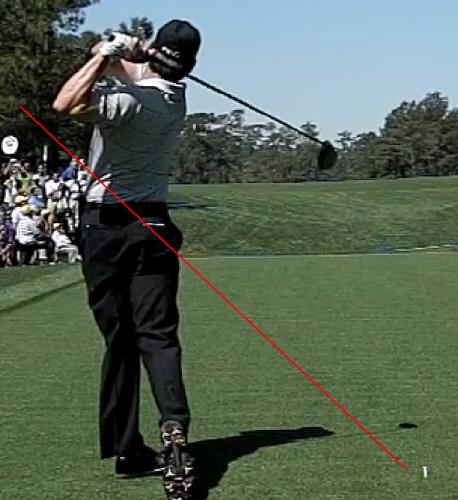
Here’s Heath Slocum with what some might call an “on plane” swing.

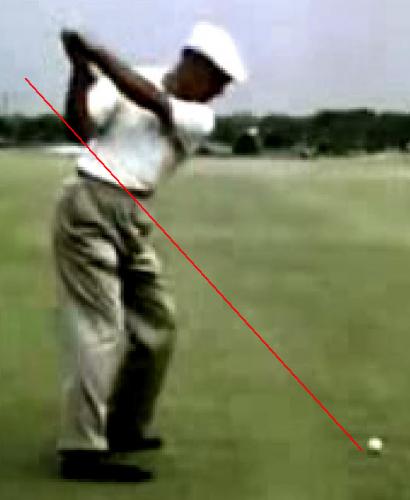
But if you’ll look carefully at his right humerus, it appears to be too far back or transversely abducted. His left arm is as flat as Ben Hogan but the right arm/shoulder position is way different.
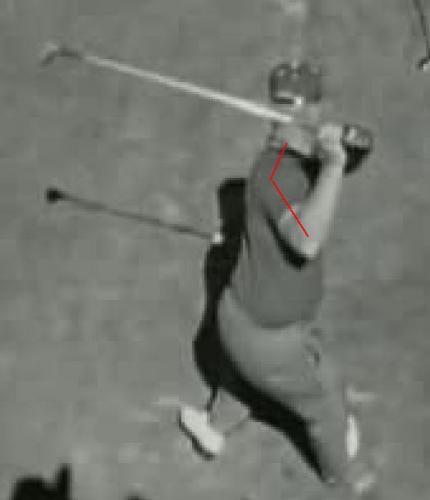
Another way of saying this is that Jack Nicklaus from above shows his right upper arm (humerus) does not become aligned with his right collarbone (clavicle).

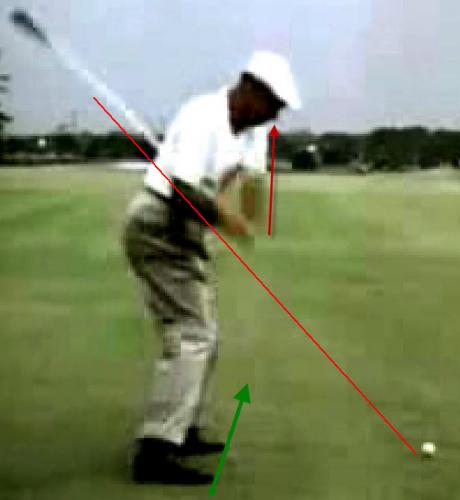
Picture #5 shows both of their shafts are almost perfectly aligned to their respective original shaft planes. One could say the butt end of the club is pointing at the ball in both cases. But Hogan’s left arm is pointed left of his feet line vs. Heath has his left arm pointed to the right of his feet line at this point. Therefore Heath’s shaft might be on plane but the hands are a bit flat and right elbow stuck behind the right hip. Hogan is slightly over and has freedom to swing left with the arms.
The left arm position has a huge influence on where the arm will move in the impact zone and, therefore, on where the club will move through impact.
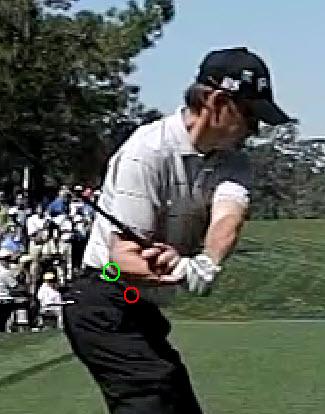
The right hip (red circle) is in front of his right elbow (green circle). Therefore his arms, generally speaking will be moving to the right as it approaches impact.

This results in a club which gets under plane by 9 o’clock and that means the path will be moving a bit to the right in the impact zone. Not that there’s anything wrong with that...
We cannot make assumptions but generally speaking this will produce a draw bias to the swing all things being equal. So we can’t say this is “on plane” if just the shaft is on plane. In a way, if the shaft matches the plane line halfway down, the hands/arm must be a bit over in order to swing the club like Hogan. That would be the one conclusion we can draw at this time.
We are getting closer to a definition of “on plane.”
Different Swing Philosophies and their Plane Preferences
So let’s take a closer look at some of the poster-child swings of the different teaching philosophies to see what they are doing. Let’s pay attention to the halfway down position with the shaft and arm position to see what appears to work best.
Tiger’s Butch Harmon plane







This swing from Tiger 2000 is probably the best given it was the greatest era of his career or in the history of golf. He basically dominated the majors and won his Tiger Slam from 2000-2001.
Top of the Backswing

This begs a potentially crucial question. Are there neutral positions that are neither steep nor flat? Perhaps that would define “on plane”? Tiger has the club pointing parallel to the feet line at the top of his backswing and above the initial shaft plane. Could that be considered neutral or “on plane”?
Halfway down
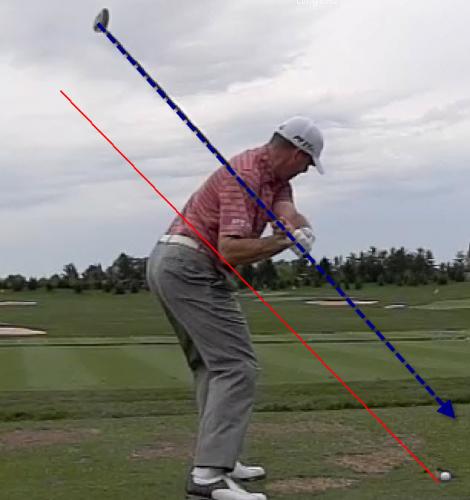

At the halfway down point, Tiger’s left arm parallel to the feet could also be considered on plane for the arms while the shaft, which is relatively parallel and above the original shaft plane, is also on plane. In 2D we see the shaft running through his lower right deltoid muscle and pointing at the ball. Maybe that’s “on plane”?
So let’s take a step back and think about this. If you are to hit the ball with the straightest, with the least amount of compensations and the ability to hit both fades and draws, wouldn’t you want a position that’s neutral? Thus at some point we do want the club to be aimed at the ball (2D distortion be careful it’s actually pointing well behind the ball or away from target). As we have seen, flatter planes like Heath’s and steeper ones like Garrigus’ do influence the path and shot shape. So let’s test this idea with other swings.
Tiger’s Hank Haney plane






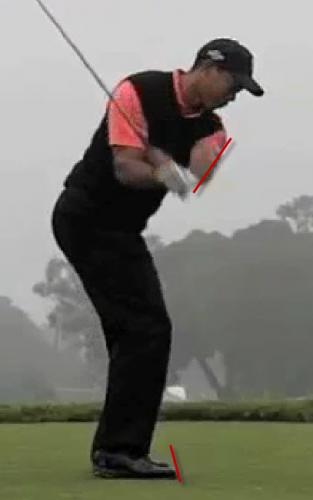
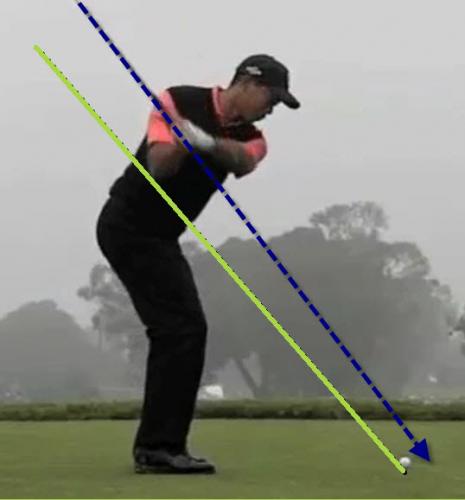
Compared to his 2000 swing, Tiger’s left arm position is a bit more pointed to the right. The shaft appears to point just over the ball and appears to run through his right deltoid. Could it be due to the theory of parallel planes?
Hank Haney has this idea of parallel planes whereby the shaft should remain parallel to the original shaft plane throughout the swing. It all looks quite pretty. But why is it Haney had Tiger a bit laid off at the top? So what does “laid off” actually mean? Definition please!
Top of the backswing position: Laid off vs. crossing the line
Golf people call a club that is pointed left of target at the top of the backswing “laid off” and a club pointed to the right of target at the top of backswing “crossing the line.” But what are the movements that create these different positions? Are all laid off and cross the line positions created similarly? Absolutely not! This is where it is not so simple.
| Laid off movements | Crossing the line movements |
| Smaller shoulder turn than 90 degrees | Larger shoulder turns |
| Increasing Right shoulder ER/Left shoulder IR | Moving to Right shoulder IR/Left shoulder ER at top of the backswing |
| Left forearm supination/right forearm pronation | Left forearm pronation/right forearm supination |
| Less radial deviation | More radial deviation |
| Left wrist flexion/right wrist extension | Left wrist extension/right wrist flexion |
These movements are all variable meaning there can be a large or small amount of the movement. Players can also mix and match laid off movements with crossing the line movements to create and “on plane” swing. So this can really get complicated. The key might be to understand what suits your particular swing tendencies/flaws.
Laid Off
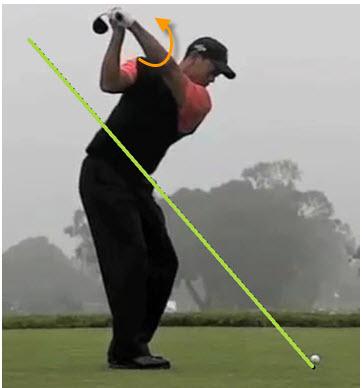
Tiger’s laid off position at the top comes from one of Haney’s ideas that you rotate the left shoulder internally (see curved arrow) as much as you can during the backswing. This also means the mirrored movement of the right shoulder would create external rotation. What this does is create a bit of stretch shorten cycle to move toward right shoulder internal rotation a bit earlier in the downswing. This can help some players who might have a club a little stuck behind them on the downswing get the club back “in front.”
Who should be careful of the laid off position?
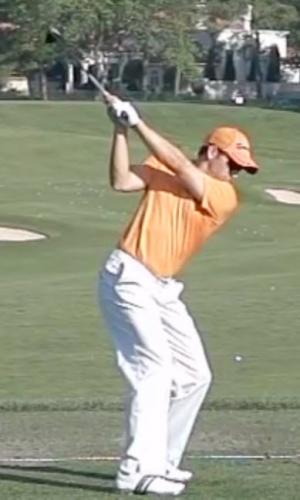
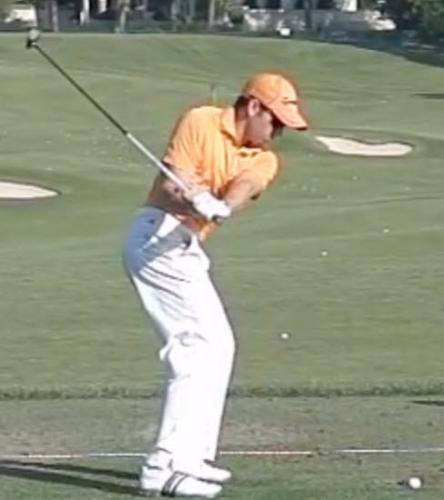
Sergio has quite a flat and laid off backswing and gets too flat as he starts his downswing. Since he is already flat and “on plane” he cannot use right shoulder external rotation and transverse adduction of the right shoulder because these moves would further flatten his downswing. He is forced to fire the right shoulder internal rotation a bit early.
Compare to Hogan who might have been a little laid off but had this huge movement to externally rotate his right shoulder to create this change in plane. Sergio doesn’t change his plane much and it eliminates some of the external rotation of the right shoulder at that point in his swing.
Crossing the Line

Announcer Judy Rankin is obsessed with Inbee’s upright cross the line backswing being caused by a lack of turn in her backswing.
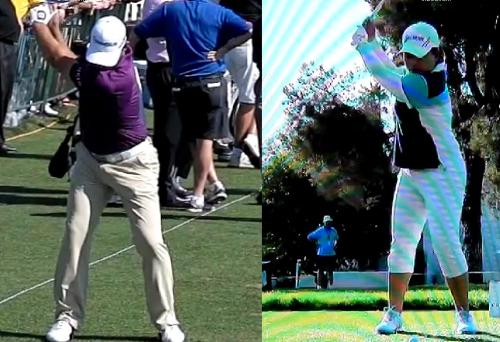
But doesn’t she appear to be turning more than Gary Woodland? Turning more would create a more cross the line position all things being equal. Surely Rankin jests.
Who should not cross the line?
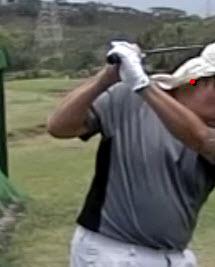

A slicer that crosses the line with a cupped wrist and left forearm pronation might have problems with this. Also, if the golfer already has tendency to fire right shoulder internal rotation as soon as the downswing starts would be in trouble with being steep and over the top.
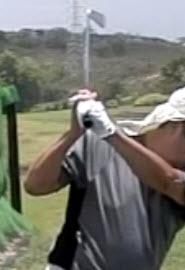 |
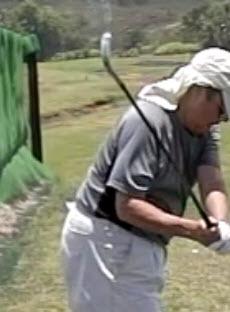 |
But the fix is not in changing the cross the line per se, it is in getting the left wrist less cupped at the top with some supination rather than the pronation he had before. Doing this, his plane flattened immediately.
Laid off, cross the line or “on plane”
As we have seen with the tour players from the previous article, there’s no real trend in terms of where the club is pointed. But for the average player, I’d look at the anatomical positions more carefully. If you have an extreme strong grip then your left wrist can be extended or cupped slightly. But if neutral to strong grip, you should seek the flat left wrist at the top similar to Tiger 2000.
Leadbetter’s Plane
Back in the late 1980’s and 1990’s when Lead was popular amongst the men pros, he taught a steep backswing with drop in plane on the downswing. Guys like Nick Faldo, Nick Price, Denis Watson, David Frost and other great players displayed this type of swing plane.

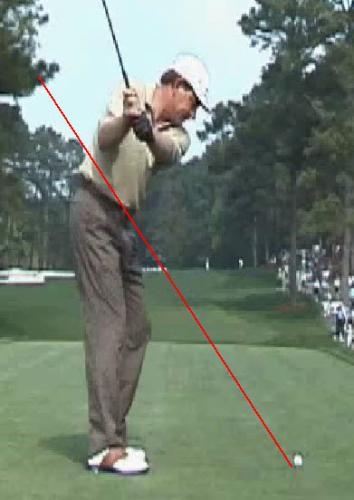

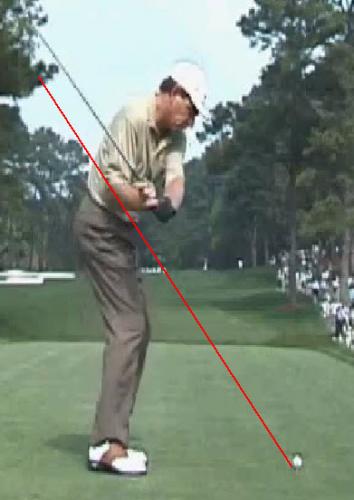
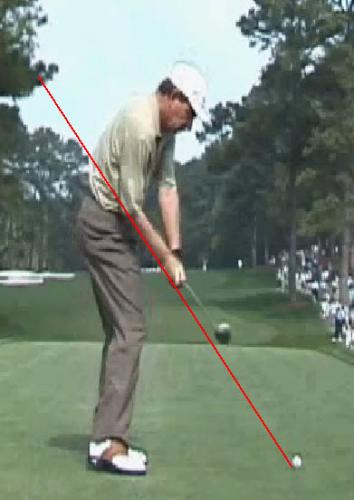
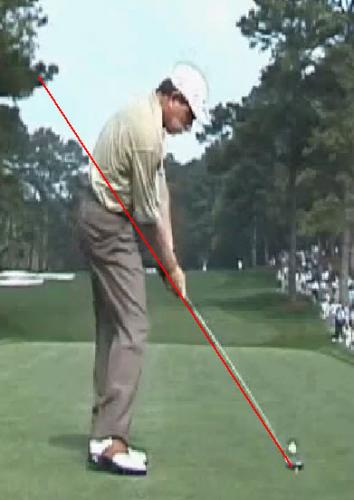
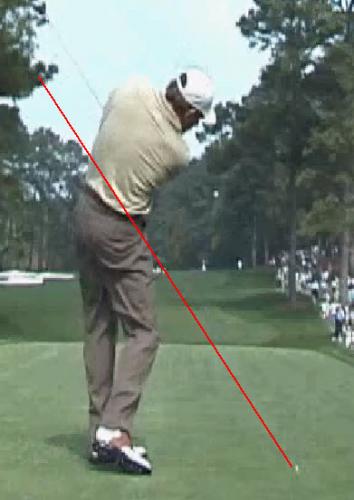
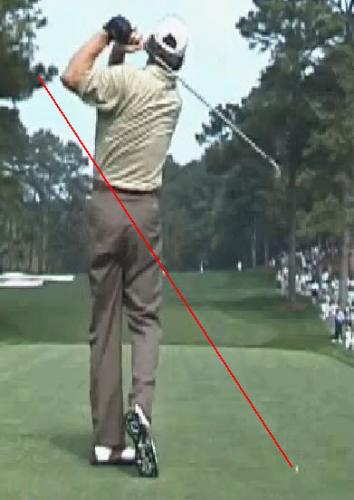
But somehow he seems to have moved away from the steep backswing despite all the success of his earlier students. So now it appears that even he has succumbed to the notion of efficiency (why go up if you’re only going to come down?) mentality that is plaguing golfers around the globe.









So here’s Suzann Pettersen’s swing plane which reflects his current theory. The club stays outside the hands on takeaway, then moves toward a flat, deeper arm swing (pic #4).
Once there you can see the “arm pumping” action (a Leadbetter favorite drill) to start the downswing (pic #5) which results in the body holding or trying not to rotate while the arm and club is brought down. But this decreases the amount of transverse adduction of the right shoulder and triggers early internal rotation of the right shoulder thus the right elbow appears to be stuck behind.
Never fear because if you stall the body enough you can flip the hands out in front at impact (pic #7).


Compare where their right elbow and left arm positions at this point. Suzann has her right elbow stuck while Nick has his elbow on the side of his hip. Suzann has her left arm pointed right while Nick has his left arm matching his feet line.
Matt Kuchar’s One Plane Swing
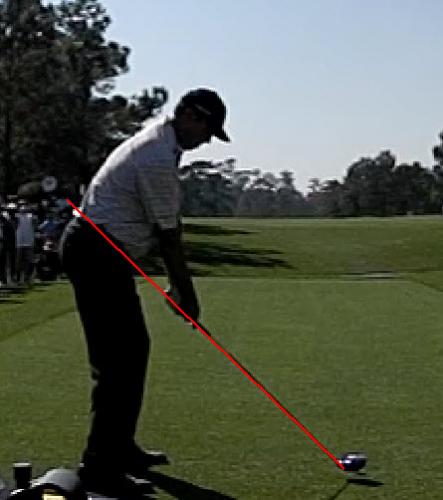
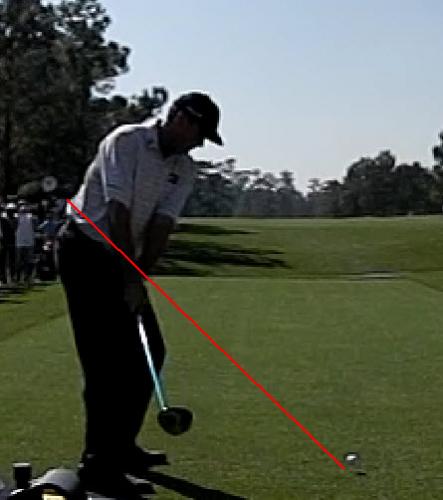
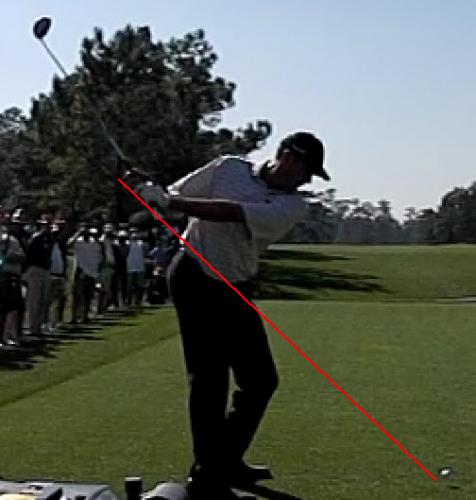
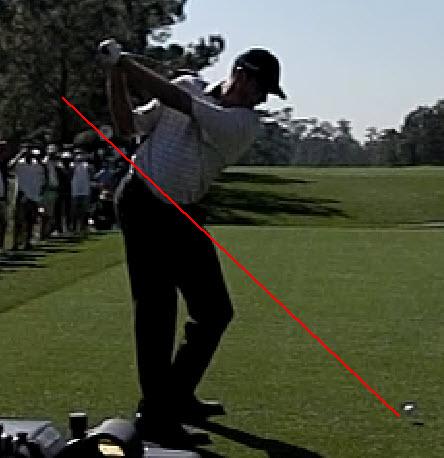
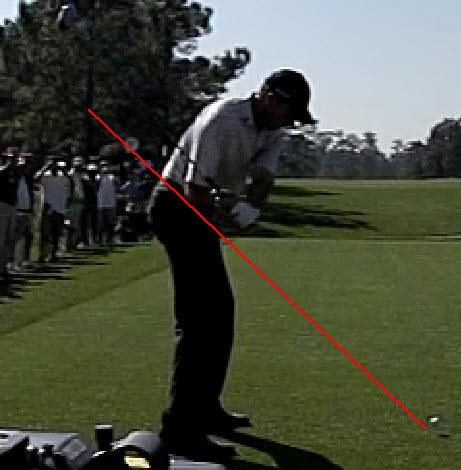

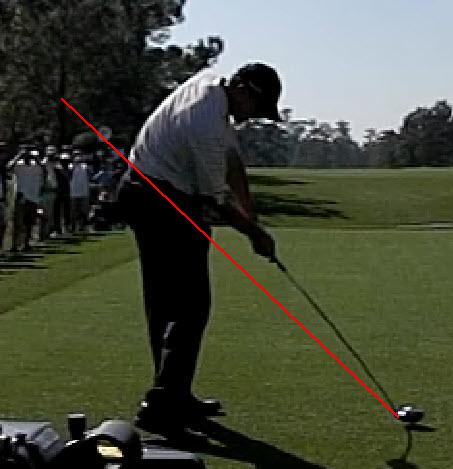
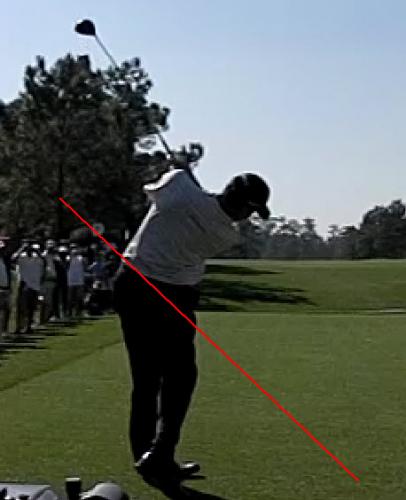
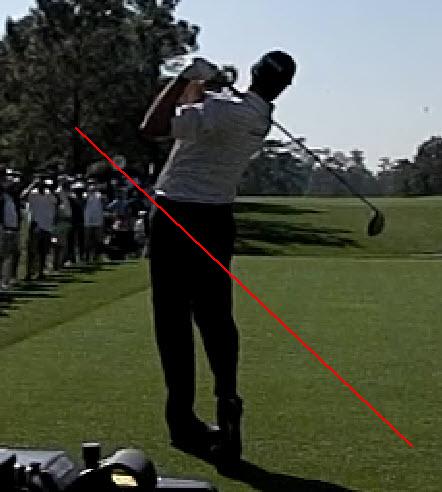
Is Matt Kuchar’s right elbow up and back as Hardy is telling his students to do? Or is Matt a bad student whose unconscious athleticism simply doesn’t listen? Picture #5 shows him in the neutral or on plane position.
I placed a red square where his right elbow pretty much stops during the backswing. From there, he’s not going to move it any farther back. He’s just pivoting at the elbow and externally rotating his right shoulder. He gets the club cross the line and has a large move to transverse adduct his right arm and further externally rotate his right shoulder. This gets his right elbow in front and it looks like any other tour pro’s swing to me. His right elbow does not stay up and back…….whatever that means.
As for all you good students that listen and don’t have the innate athletic sense to ignore questionable instruction, you’re fighting an uphill battle.
Charlie Wi’s S&T plane
It seems the stack and tilt crowd and the golf machine guys like flat swings. But while the takeaway and backswing are flatter for Charlie (pics #2 and #3)...
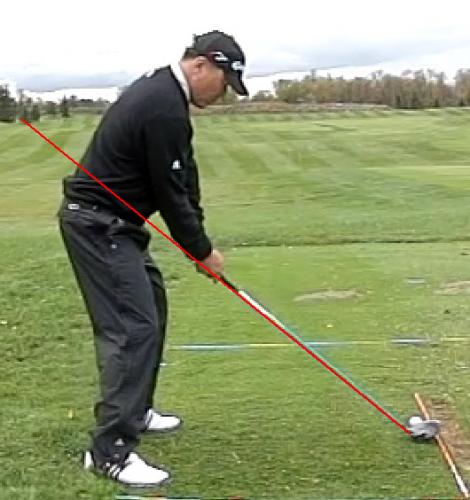
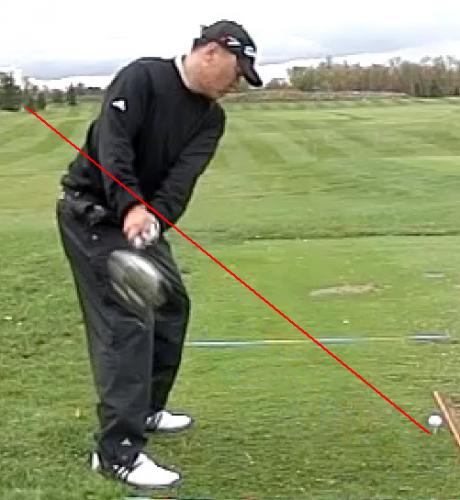

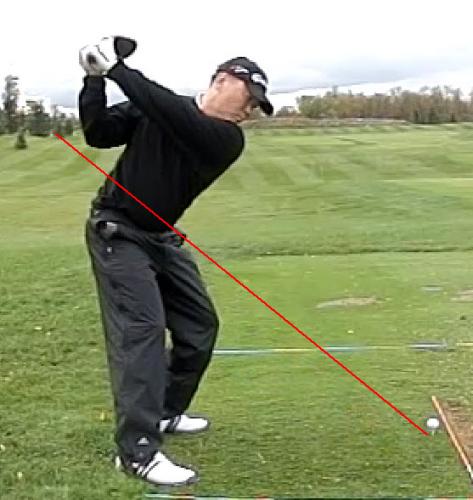
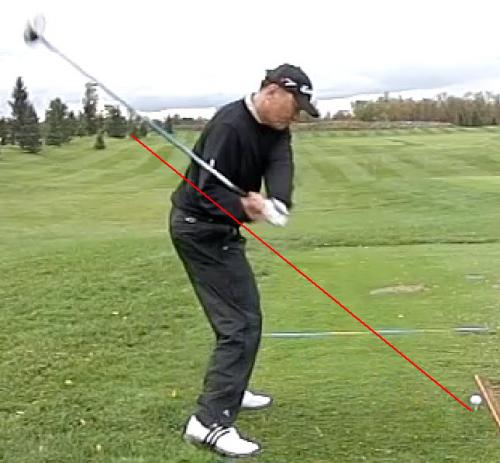
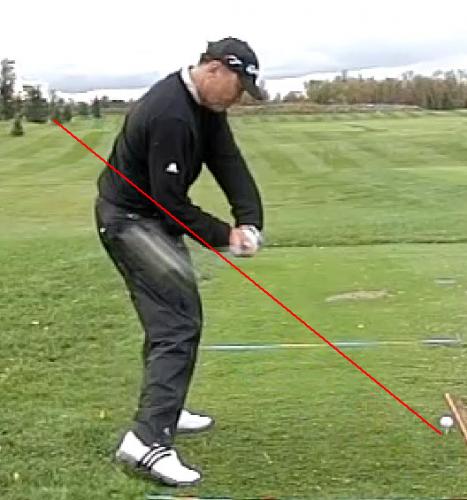


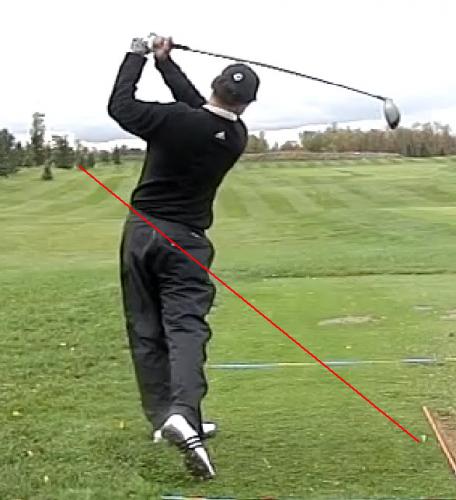
By the time Charlie reaches the top of his backswing and starts down, it is not much different than other tour pros. Picture #5 shows him in the flat and over position.
What the Legends Did
Nicklaus
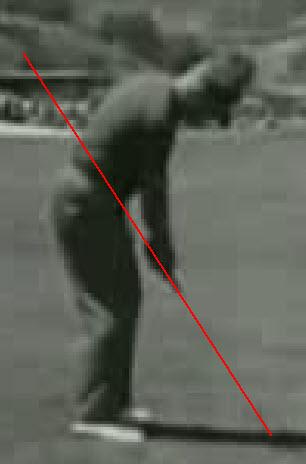
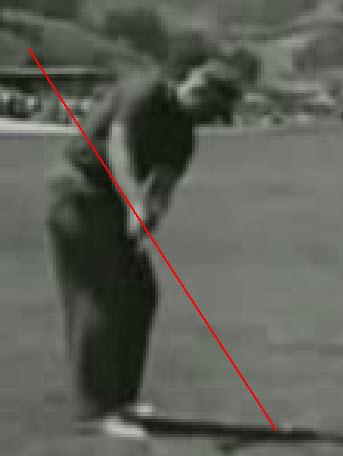
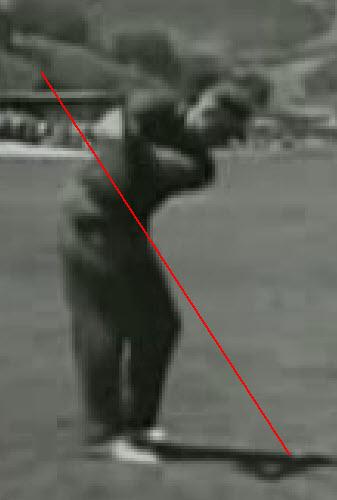
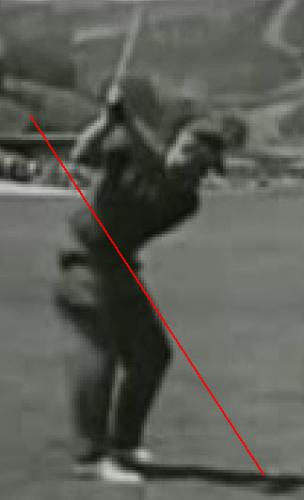


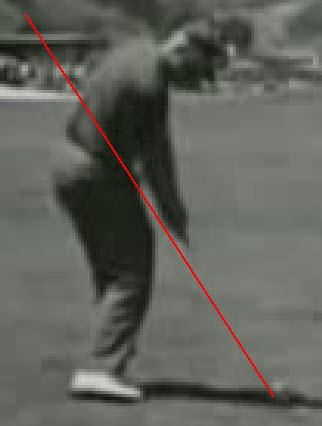
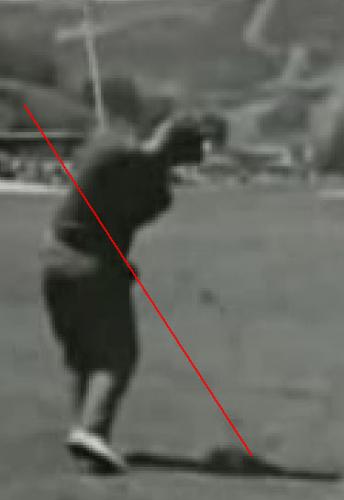
Picture #5 show Jack in the neutral or on plane position.
Ben Hogan
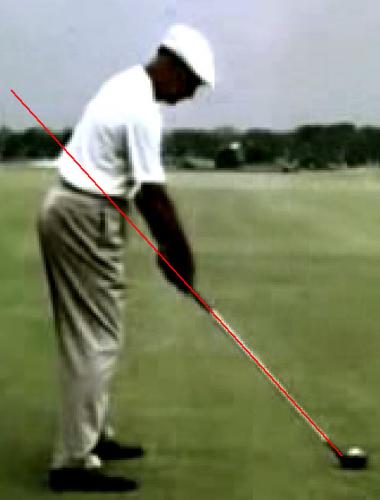
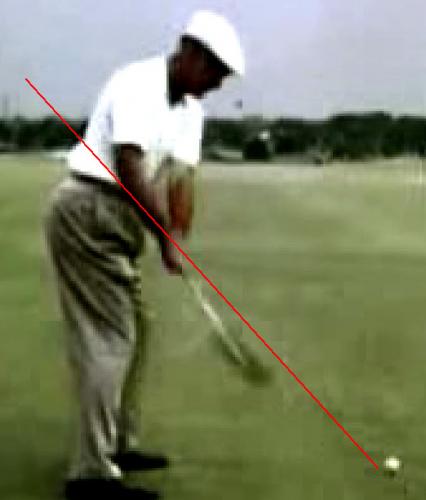
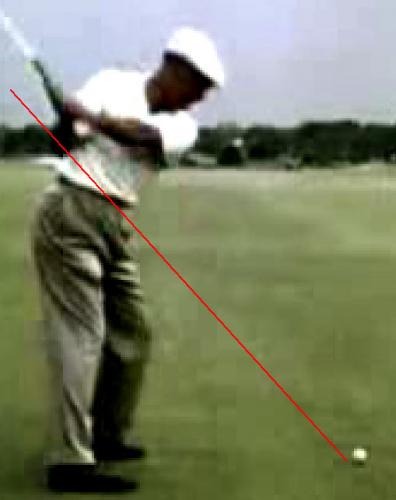

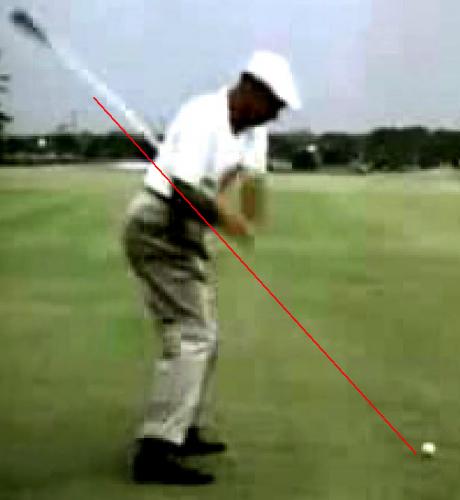
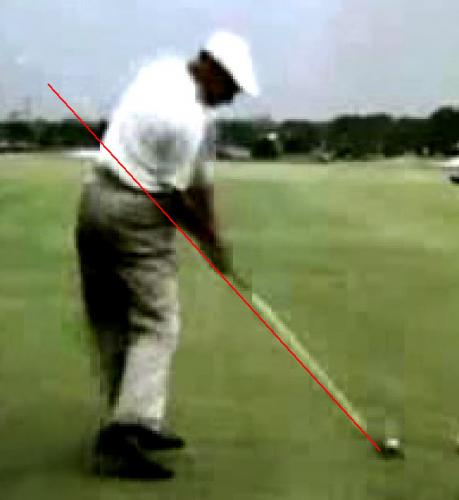
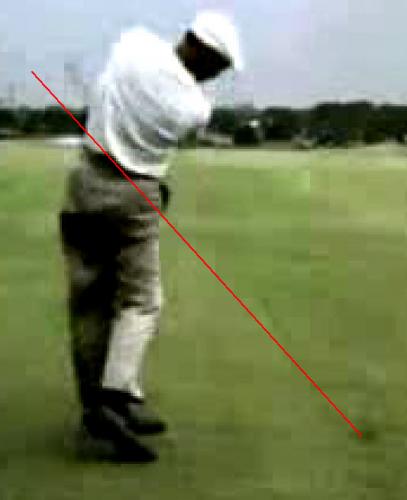
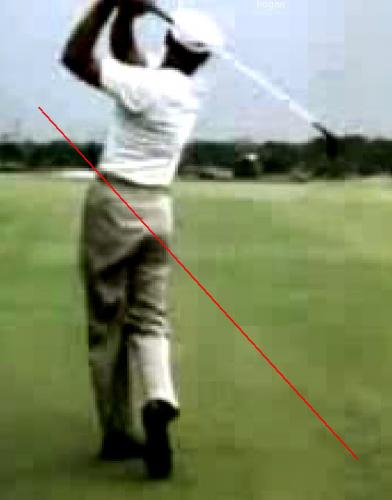
Hogan is in the flat and over position at picture #5.
Jackie Burke
Here’s the great Jackie Burke showing the flat and over position. He and the great Sam Snead had these flat backswings then swung a little over on the downswing. However, there is a big difference between an amateur over the top move and the legends’; amateurs do it with early right shoulder internal rotation while the legends are doing this with tremendous body rotation, external rotation/transverse adduction of the right shoulder.
Summary
While there are huge variations in backswing plane, from very flat to very upright, there seems to be a trend in terms of downswing planes for the pros. They are either “on plane” or they have the flat shaft with steep hands (option #4) and maybe a few with flat shaft/hands (option #2).
The amateurs are typically in the first three options:
- Steep shaft with steep hands = steep (over the top)
- Flat shaft with flat hands = flat (usually stuck)
- Steep shaft with flat hands = steep and stuck
Generally speaking, the steep shaft positions are caused by early right shoulder internal rotation. The stuck positions are caused by the improper vertical drop of the hands/arms without ample body rotation. Of course there could be other reasons for the incorrect swing planes (incorrect spine movements) but generally speaking this would be a good place to start working if you are flat/stuck or steep.
In a way, many golfers understand what too steep is but I don’t think people understand what too flat is. Judging by the halfway down position it seems that many better than average amateur golfers have overly flat shaft and hand positions on the downswings in comparison to the pros and struggle because of it. I shall take a closer look at this in my next article.
Note: For teachers wanting to learn more about the spine movements in the swing and obtain PGA continuing education credits, my spine mechanics course is ready. Still working on the release styles and lower body movements courses so give me another month or so and I’ll have it ready. Contact me at This email address is being protected from spambots. You need JavaScript enabled to view it. for more information.

